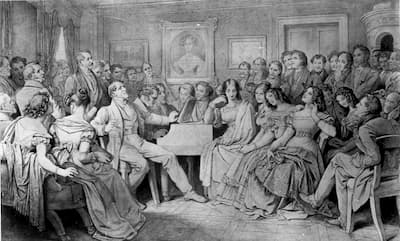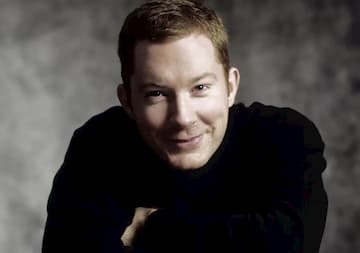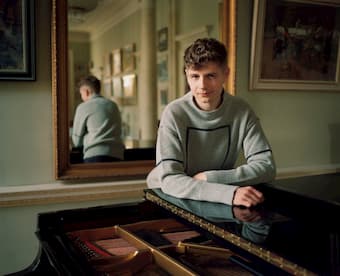Graham Johnson, piano
6 October 2020: Schubert
This concert will be live streamed on the Wigmore Hall website in HD, and all concerts in the Autumn Series will be available on demand for 30 days after the date of the concert. This generous gesture, which is offered free of charge (though the hall welcomes donations from viewers), will enable thousands of people around the world to enjoy fine music-making from London’s premier chamber music venue. For full details, please visit the Wigmore Hall’s website.

Schwind: Schubertiade (1868)
The image is famous – a gathering at Schubert’s house where he’s playing his latest songs – a Schubertiade! We see Schubert at the piano, Johann Michael Vogl sitting next to him singing, and all his friends around. This drawing, in sepia, was made by Moritz von Schwind, and, allegedly, was painted “from memory”. It dates from 1868.

Julius Schmid: Schubertiade (1897)
A depiction from 30 years later has raised the stakes and improved the stage immeasurably – the women are in the most fashionable of gowns, the room is so crowded that attendees are to the walls, and no one is recognizable as any of Schubert’s known friends.

Robin Tritschler
In Schwind’s 1868 picture Franz Schubert at the piano at Joseph von Spaun’s house and in the room are Joseph von Spaun (noble and friend of Schubert’s), Johann Michael Vogl (baritone), Franz Lachner (composer), Moritz von Schwind (painter), Wilhelm August Rieder (painter), Leopold Kupelwieser (painter), Eduard von Bauernfeld (playright), Franz von Schober (poet and librettist), Franz Grillparzer (writer). The picture on the wall is Countess Karoline Esterházy. The other women in the room, unfortunately, are unidentified.

Graham Johnson
© Clive Barda
You can participate in your own Schubert evening, live from Wigmore Hall on 6 October when tenor Robin Tritschler and pianist Graham Johnson take the stage with a range of Schubert songs. Spanning a 14-year period of 1812 to 1826, the songs begin with an early setting of Schiller’s ‘Der Jüngling am Bache”, D. 30, which takes the metaphor of throwing flowers into a stream and turns it into a tale of possibly to-be-requited love.
Schubert: Der Jungling am Bache, D. 30 (1st setting) (Dietrich Fischer-Dieskau, baritone; Gerald Moore, piano)
The last work, chronologically, is a setting of Schulze’ “Im Frühling”, Op. 101/1, D. 882, another tale of love. But now we can hear Schubert’s greater mastery of not only the lyrics but also of the accompaniment.
Schubert: Im Frühling, Op. 101, No. 1, D. 882 (John Mark Ainsley, tenor; Malcolm Martineau, piano)
Between these two works lies a world of song, from the agonized “Wandrers Nachtlied”, Op. 4/3, D. 224, where the weary wanderer, driven from place to place, seeks peace, to “Ganymede”, Op. 19/3, D. 544, which mixes the metaphors of eternal love, Roman mythology, and a seemingly Christian ending!
Schubert: Wandrers Nachtlied I, Op. 4, No. 3, D. 224 (Dietrich Fischer-Dieskau, baritone; Gerald Moore, piano)
Schubert: Ganymed (Ganymede), Op. 19, No. 3, D. 544 (Martina Arroyo, soprano; Leonard Hokanson, piano)
The concert covers songs by some of the greatest German poets, Schiller and Goethe as well as some minor poets: Matthisson, Mayrhofer, and Schulze.
In this setting of Schulze’ “An mein Herz”, D. 860, the song that the poet addresses to his heart (‘Why are you pounding so savagely?’) is matched in the piano’s urgent line.
Schubert: An mein Herz, D. 860 (Matthias Goerne, baritone; Helmut Deutsch, piano)
Each song brings its own world of love and sorrow, joy and pain, and, in the voice of Robin Tritschler and the hands of Graham Johnson, you can attend your own private Schubertiade.






